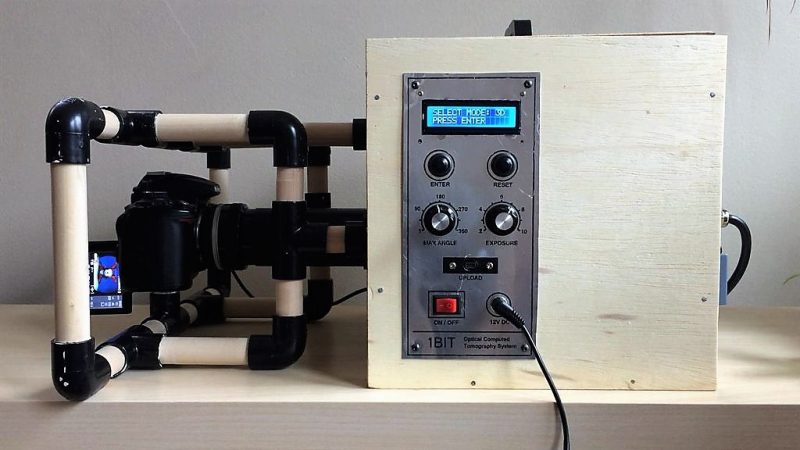If you’ve ever experienced the heartbreak of finding a seed in your supposedly seedless navel orange, you’ll be glad to hear that with a little work, you can protect yourself with an optical computed tomography scanner to peer inside that slice before popping it into your mouth.
We have to admit to reading this one with a skeptical eye at first. It’s not that we doubt that a DIY CT scanner is possible; after all, we’ve seen examples at least a couple of times before. The prominent DSLR mounted to the scanning chamber betrays the use of visible light rather than X-rays in this scanner — but really, X-ray is just another wavelength of light. If you choose optically translucent test subjects, the principles are all the same. [Jbumstead]’s optical CT scanner is therefore limited to peeking inside things like slices of tomatoes or oranges to look at the internal structure, which it does with impressive resolution.
This scanner also has a decided advantage over X-ray CT scanners in that it can image the outside of an object in the visible spectrum, which makes it a handy 3D-scanner in addition to its use in diagnosing Gummi Bear diseases. In either transmissive or reflective mode, the DSLR is fitted with a telecentric lens and has its shutter synchronized to the stepper-driven specimen stage. Scan images are sent to Matlab for reconstruction of CT scans or to Photoscan for 3D scans.
The results are impressive, although it’s arguably more useful as a scanner. Looking to turn a 3D-scan into a 3D-print? Photogrammetry is where it’s at.















Wow! Very creative build, very nice video, and high concept project. Just wonderful!
This is exactly the sort of project I come to Hackaday for.
Holy balls batman! Photoscan is $3500usd! So much for that idea says a regular maker
At least you only need PhotoScan for the front-surface illumination things? The CT work probably can run in Octave.
cant you still download Autodesk 123D Catch?
Photoscan used to be free for individuals, I guess they smelled that drone business going their way.
There is other software for photogrammetry:
https://en.wikipedia.org/wiki/Comparison_of_photogrammetry_software
Pff, everything is free with the right google search.
The standard edition is only $180. If you just using it for object reconstruction yo won’t need the professional edition.
RealityCapture is better, though (IMHO)
Okay, since I have read I would have to invest thousands of dollars … Sorry, you just missed the goal in my opinion.
Lucky for [Jbumstead], he wasn’t building to your goals. You can take or leave the results however you like.
Wow! What an amazing project. Congratulations on your outstanding build and the awesome way you documented it.
surprised no one has mentioned VisualSFM & Meshlab as an alternative to these expensive photogrammetry software packages.
Because it is a pain in the ass to use, takes longer and delivers inferior results?
I wonder if you replaced the IR LED panel with a single EHF (241.000 GHz – 250.000 GHz – 1mm wavelength) RF transmitter, and the camera with a single 1mm feed horn for a RF receiver and instead of scanning the object in a circle, scanning it spherically. Maybe place the item to be scanned on a low RF attenuation (@1mm wavelength) platform.
Ooh. There’s an idea. A single sensor doesn’t get you nearly as much information as an array of sensors, though, so the scan would need to take much longer. Still, this would give something more like an X-ray, without the hazards of X-rays.
The backscatter radar used in airport scanners does something like this, but I think they use a phased array for both the source and the detector, which is what allows them to do a scan in just a couple seconds.
Welp, silicon for 77GHz automotive radars is getting cheap, but I don’t know about anything up in the EHF range.
There are negative resistance oscillator circuits which use Gunn diodes (TED – Transferred Electron Device) to generate RF at really high frequencies.
GaAs Gunn diodes for 10 GHz to 200 GHz
GaN Gunn diodes up to 3 THz
The frequency of operation is mostly decided by the width of the lightly N-doped layer between the two heavily N-doped layers at the time of manufacture, but can be varied slightly by the external LC resonance circuit. Technically it should never have been called a diode, but historically it was. It is a bit like current flowing from positive to negative in the opposite direction to actual electron flow, it is a bit late to change billions of textbooks.
Mostly used by the Military, so not a common item, and probably covered by ITAR restrictions.
Interesting project, very informative video. Thanks for posting.
Great post really gets me thinking of building one similar the software is the kicker luckily the standard edition has the Photogrammetric package included and its only $179 and students $59 , not really that bad.
Finally a REAL article about hacking!!
Amazing post! good job… I think the same writing style continues.
https://www.hpsupportphonenumbers.com/blog/fix-hp-accelerometer-error-windows-10/
If you want to know about Why Hp Printer Offline, dial the toll-free Hp Printer Helpline Number now i.e 1 805-791-2114. Our team of experts is always there to help you regarding HP Printer Offline, HP Printer is Offline, Why HP Printer is Offline, Why Is My HP Printer Offline, or HP Printer Is Offline Fix.
Why Hp Printer Offline
Hp Printer Not Working
Hp Printer Is Offline How to Fix
Hp Printer Offline
Hp Printer Offline Fix
Hp Printer Showing Offline
Why Hp Printer Is Offline
Hp Printer Not Printing
Hp Printer Won’t Connect To WiFi